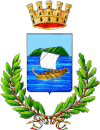Olbia, Italy
|
Olbia Terranòa Tarranòa |
||
|---|---|---|
| Comune | ||
| Comune di Olbia | ||
 |
||
|
||
| Location of Olbia in Sardinia | ||
| Coordinates: 40°55′N 09°30′E / 40.917°N 9.500°E | ||
| Country | Italy | |
| Region | Sardinia | |
| Province / Metropolitan city | Olbia-Tempio | |
| Frazioni | Berchiddeddu, Murta Maria, Pittulongu, Rudalza-Porto Rotondo, San Pantaleo | |
| Government | ||
| • Mayor | Settimo Nizzi (Forza Italia) | |
| Area | ||
| • Total | 383.64 km2 (148.12 sq mi) | |
| Population (28 February 2017) | ||
| • Total | 60,007 | |
| • Density | 160/km2 (410/sq mi) | |
| Demonym(s) | Olbiese, Olbiesino (pejorative) | |
| Time zone | CET (UTC+1) | |
| • Summer (DST) | CEST (UTC+2) | |
| Postal code | 07026 | |
| Dialing code | 0789 | |
| Patron saint | San Simplicio | |
| Saint day | May 15 | |
| Website | Official website | |
Olbia (Italian: [ˈɔlbja],locally [ˈolbja]; Sardinian: Terranòa; Gallurese: Tarranòa) is a city and comune of 59,885 inhabitants (November 2016) in northeastern Sardinia (Italy), in the Gallura sub-region. Called Olbia in the Roman age, Cività in the Middle Ages (Giudicati period) and Terranova Pausania before the 1940s, Olbia was again the official name of the city during the period of Fascism.
It is the economic centre of this part of the island (commercial centres, food industry) and is very close to the famous Costa Smeralda tourist area. It was one of the administrative capitals of the province of Olbia-Tempio, operative since 2005 and canceled after a referendum seven years later. A dynamic city, which presents itself as a tourist destination, for the beautiful sea and beaches and also for the large number of places of cultural interest to visit.
Olbia (the name is of Greek origin) is very ancient and was possibly founded by the Greeks, although the name is of Greek origin due to the Greek presence during the 7th century bc, the city was first settled by Phoenicians, according to the archaeological findings. It contains ruins from nuragic to the Roman Era, when it was an important port, and the Middle Ages, when it was the capital of the Giudicato of Gallura, one of the four independent states of Sardinia.
From 1113 it was the episcopal see of the Diocese of Cività (succeeding to the Diocese of Gallura, the 1070 restoration of the Diocese of Fausania, c. 500–750), which was renamed in 1839 as Diocese of Civita–Tempio until its formal suppression in favor of (in fact merger into) the Diocese of Tempio–Ampurias (also integrating the Diocese of Ampurias, which was in personal union with the see of Civita from 1506)
...
Wikipedia


